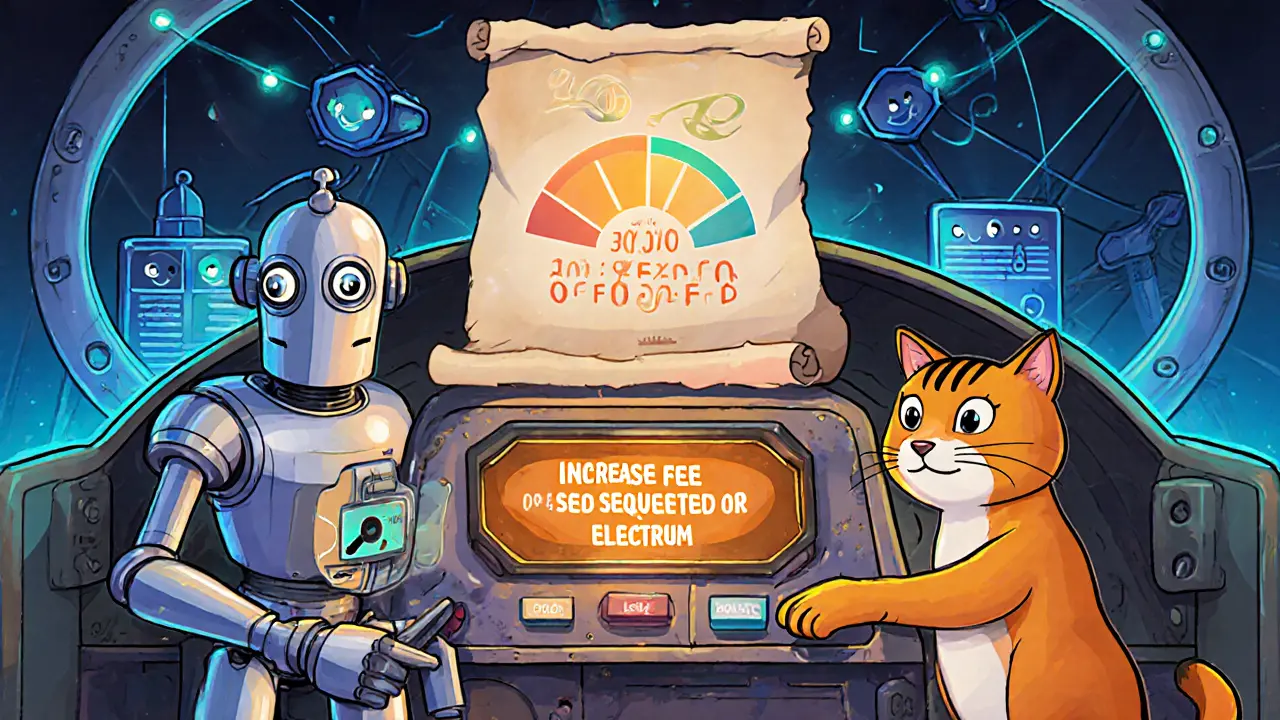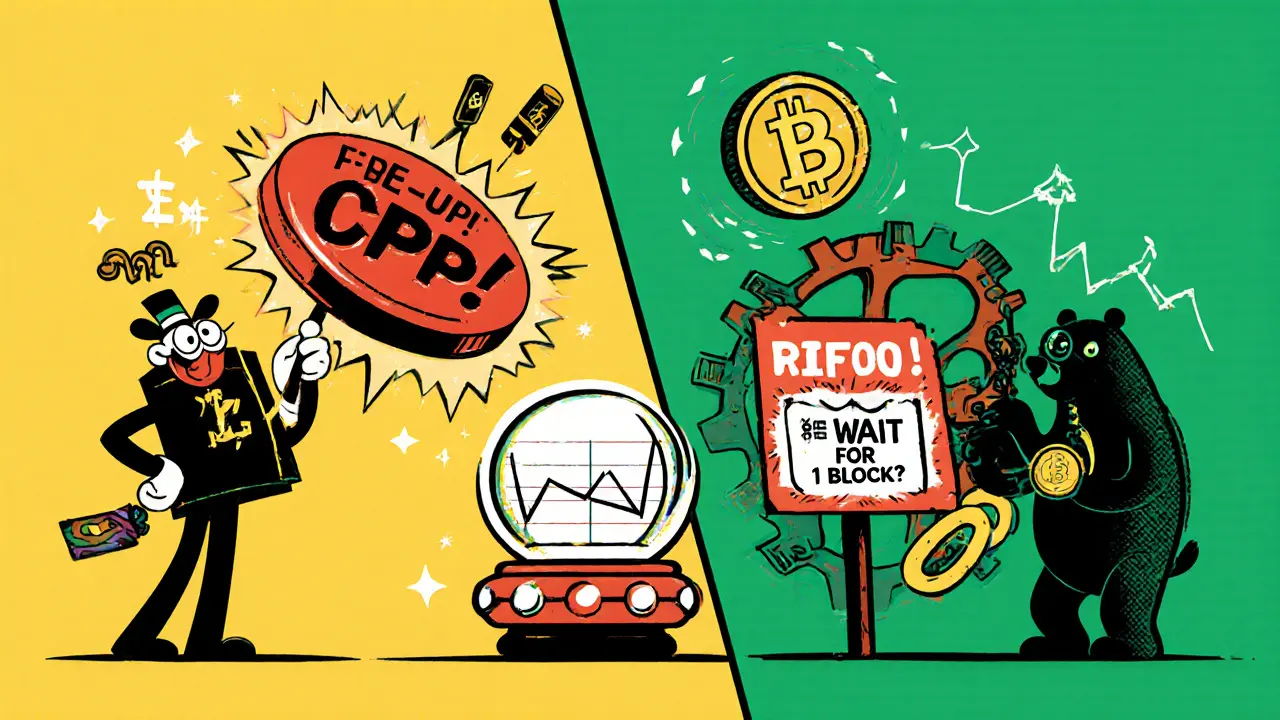Replace-By-Fee (RBF) Explained: How Bitcoin Transactions Get Faster Confirmation

Jun, 28 2025
Bitcoin RBF Fee Calculator
Current Transaction Details
RBF Requirements
To successfully bump a transaction using Replace-By-Fee (RBF), you must:
1. Minimum increase: At least 1 sat/vByte higher than original
2. Minimum total increase: At least 1,000 satoshis total
Note: Current mempool congestion may require higher fees than minimums.
Results
How It Works
This calculator uses Bitcoin's RBF rules to determine the minimum fee increase required for faster confirmation:
- 1. Must increase fee by at least 1 sat/vByte over original
- 2. Must increase total fee by at least 1,000 satoshis
- 3. New fee rate must be competitive with current mempool levels
Note: Some wallets automatically calculate the ideal bump based on network conditions.
When a Bitcoin transaction sits stuck in the mempool, the easiest way to speed it up is to raise its fee. That’s exactly what Replace-By-Fee (RBF) is a protocol feature that lets users broadcast a new version of an unconfirmed transaction with a higher fee does. The idea first appeared in the early days of Bitcoin, was shelved for security reasons, and returned in 2015 as BIP 125 the formal Bitcoin Improvement Proposal that defines opt‑in RBF signaling. Since then, most major wallets and nodes support it, turning fee‑bumping from a niche trick into a everyday tool.
Why RBF Matters in Today’s Bitcoin Landscape
Network congestion spikes whenever price rallies or major events drive a flood of transactions. During the December 2017 bull run, average fees jumped from about $2 to over $50 in a month. More recently, the January 2024 Bitcoin‑ETF approval flooded the mempool with >300,000 unconfirmed transactions. In those moments, a transaction with a low fee can linger for hours-or even days-while miners prioritize higher‑paying packets. RBF gives the sender direct control: bump the fee, keep the same outputs, and let the network treat the new transaction as the one to confirm. No need to wait for a recipient to co‑operate or to create a separate child transaction.
How RBF Works Under the Hood
The mechanism hinges on a simple signaling rule. When a wallet creates a transaction, it sets the sequence number of each input to a value lower than 0xFFFFFFFE (MAX_INT‑1). This tells nodes, “I might replace this later.” A replacement transaction must meet two fee conditions: it must pay at least 1 satoshi per virtual byte more than the original, and it must increase the total fee by a minimum of 1,000 satoshis. These thresholds stop spam attacks while still allowing meaningful bumps.
Only nodes running Bitcoin Core the reference implementation of the Bitcoin protocol, version 0.12.0 and later enforce the rules automatically. Once a transaction gets even a single confirmation, it becomes immutable-RBF can’t touch it after that.
Step‑by‑Step: Bumping a Transaction with RBF
- Open a wallet that supports RBF (e.g., Trezor Suite desktop client for Trezor hardware wallets or Electrum).
- Locate the pending transaction in your history. It will be marked “unconfirmed” and flagged as replaceable.
- Select “Increase fee” or “Bump fee.” The UI will suggest a new fee rate based on current mempool pressure.
- Confirm the bump. The wallet creates a new transaction with the same inputs and outputs, a higher fee, and the proper sequence number.
- Broadcast the new transaction. Nodes drop the old version from the mempool and replace it with the fresh, higher‑fee version.
Most modern wallets finish this flow in under a minute, and the bumped transaction typically confirms within the next 1‑3 blocks when the mempool is moderately full.

RBF vs. Child‑Pays‑For‑Parent (CPFP)
Both RBF and CPFP aim to rescue stuck payments, but they approach the problem from opposite ends. RBF is sender‑centric: you raise the fee on your original transaction. CPFP is recipient‑centric: the receiver spends the stuck output in a new transaction that pays enough fee to cover both.
| Aspect | Replace‑By‑Fee (RBF) | Child‑Pays‑For‑Parent (CPFP) |
|---|---|---|
| Who initiates? | Sender | Recipient |
| Control over fee? | Direct - sender sets exact bump | Indirect - recipient decides child fee |
| Typical fee overhead | ~15 % less than CPFP (per BitGo 2022) | Higher total fee because both txs pay |
| Adoption among wallets | ~89 % of top‑50 wallets support | ~76 % support |
| Merchant acceptance | 62 % of merchants still require 1 confirmation | Often preferred when merchant can’t wait for sender action |
| Complexity for user | Simple UI bump, 2‑3 clicks | Requires recipient to create a child transaction |
In practice, most individual users pick RBF because it’s quicker and doesn’t depend on the other party’s wallet.
Real‑World Use Cases and Community Feedback
During the January 2024 ETF approval surge, Reddit users shared screenshots of transactions that went from 50 sat/vB to 150 sat/vB with RBF and confirmed in the next block. One user reported paying an extra $3.27 to avoid a 12‑hour wait. On the merchant side, BitPay’s documentation still advises waiting for one confirmation before marking an invoice paid, highlighting the lingering trust gap. Surveys from CoinDesk (2023) show that 41 % of all unconfirmed Bitcoin transactions in Q1 2024 used RBF, up from 29 % a year earlier. Institutional players are more cautious: BitGo’s Q1 2024 analytics indicate only 33 % of large‑ticket trades (> $10 k) rely on RBF, preferring immediate confirmations.
Critics point out the double‑spend risk: an unconfirmed RBF‑enabled transaction can be replaced with a completely different output, which is why many merchants still wait for a block. The “double‑spend controversy” of January 2024, covered by CoinDesk, involved a high‑value RBF transaction that was swapped before confirmation, prompting exchanges to tighten monitoring.

Limitations and Gotchas
- One confirmation lock: once a transaction gets its first block, RBF no longer works.
- Network propagation threshold: if an original tx has already reached ~85 % of peers, nodes may reject replacements to protect bandwidth.
- Incompatibility with certain scripts: Lightning Network channel openings that use anchor outputs can’t be RBF‑bumped without special support.
- User confusion: some wallets display “additional confirmed Bitcoin” requirements that bewilder newcomers.
Most of these pitfalls are mitigated by clear UI cues-Electrum’s 2023 update adds a “RBF not allowed” warning when a transaction is already confirmed or too widely propagated.
Future Outlook: RBF in the Evolving Bitcoin Ecosystem
Developers are already extending RBF to newer transaction types. BIP 322 a proposal for signed messages that also enhances RBF handling for taproot outputs includes optional fields to make fee bumps smoother for complex scripts. Lightning Labs’ experimental RBF‑compatible channel management in LND 0.17.0‑beta hints at future Layer 2‑on‑Chain interactions where fee flexibility remains valuable. Analysts at the Bitcoin Policy Institute predict RBF usage could rise to 65 % of all transactions by 2026, driven by better fee‑estimation tools and continued congestion spikes. At the same time, as more payments move to Lightning or other roll‑ups, the need for on‑chain fee bumps may shrink for everyday micro‑transactions. Still, for large settlements, time‑sensitive contracts, or NFT minting events that still rely on the main chain, RBF is likely to stay a core piece of the toolbox.
Quick Takeaways
- RBF lets you replace an unconfirmed Bitcoin transaction with one that pays a higher fee.
- Implemented via BIP 125; supported by > 85 % of top wallets.
- Works best for sender‑controlled fee bumps; cannot be used after one confirmation.
- Compared to CPFP, RBF is usually cheaper and simpler for the sender.
- Adoption is growing, but merchants often still wait for a block to mitigate double‑spend risk.
Can I use RBF with any Bitcoin wallet?
Most modern wallets-Trezor Suite, Electrum, BlueWallet, and BitPay-support opt‑in RBF. Older or very lightweight apps may not expose the feature, so check the settings or help center.
What fee increase is required for a successful bump?
The replacement must add at least 1 sat/vByte over the original and increase the total fee by a minimum of 1,000 satoshis. Most wallets calculate a higher bump automatically based on current mempool pressure.
Is RBF safe for large payments?
Technically it works, but because an unconfirmed RBF transaction can be replaced, many exchanges and merchants require at least one confirmation for high‑value transfers. Use RBF for speed, but wait for a block if the amount is critical.
How does RBF differ from the original replaceable transaction concept?
The early version lacked fee‑increase requirements and was vulnerable to denial‑of‑service attacks. Opt‑in RBF (BIP 125) adds explicit signaling and a mandatory fee bump, preventing spam while keeping the feature useful.
Can I combine RBF with CPFP?
Yes. If a sender bumps the fee but the transaction remains stuck, the recipient can still create a child transaction (CPFP) to force confirmation. Using both gives extra insurance.